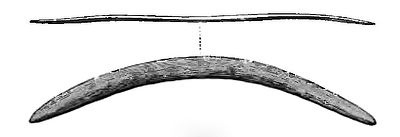and he said he did not know. All the time I was speaking to him he was examining the weapon attentively. He asked me many questions respecting it—as to the native who made it, where it came from, &c.—and after having satisfied him on these points as well as I was able, he requested permission to make trial of it. I gave permission, and in a short time he had discovered its peculiarities, and threw it in such a manner as to surprise all who beheld his efforts. The weapon made many astonishing flights, and came back as obediently as the larger and heavier weapons which he had been accustomed to use.
In the hands of a native, the Wonguim always comes back, and there is no such thing as failure when it is thrown by a skilled warrior.
It is dangerous to stand near the thrower, if the observer have not self-possession. When the instrument returns, it is necessary to look at it attentively, and not to move unless it comes too nigh; any hurried movement, due to alarm, for the purpose of avoiding it, might result in its striking the affrighted person and inflicting a serious wound. The plan is to stand quite still, and to wait patiently until the force is expended. The thrower, if skilful, will take care that, if the observers keep their places, none of them are injured.
The natives o fa part of the River Murray (near Kulkyne) name the "come-back" boomerang Wittoo-ah-wil.
Barn-geet.
The Barn-geet, Ban-geek, or Barn-geek of the natives of the Yarra, the war-boomerang, is shown in Fig. 96. It is most commonly used in battle. Many of the specimens in my possession are at first sight undistinguishable from the Wonguim, but when the characters of the several weapons are understood, it is not difficult to separate the come-back boomerangs from those which do not return when thrown.

|
| FIG. 96. |
Usually, the Barn-geet is not so much curved as the Wonguim, and the best weapons are nearly as straight as the blade of a sword; there is seldom any twist as in the Wonguim; but some are twisted, though not in the same manner as the weapon that returns.
They are made of the hardest woods, are very neatly fashioned, and have a sharp cutting edge. In battle they are dangerous weapons.
The length of the weapon shown in the figure is thirty inches, the breadth is an inch and three-quarters, and the greatest thickness of the blade is half an inch. The weight is ten ounces, which appears to be the ordinary weight of a good weapon, but some are as light as eight ounces.
